Over the years BMW has dabbled with just about every type of car possible, from microcars to mid-engined supercars and just about everything in between but it could be argued that its very essence, its raison d’etre if you like, is to produce the finest sporting saloons on the planet. The M3 and M5 are at the very core of the company and perhaps no other machine defines BMW quite as admirably as the E28 M5. It was the first of the M-powered saloons and was an utterly wonderful piece of kit, offering supercar performance wrapped up in a sober and practical four-door suit.
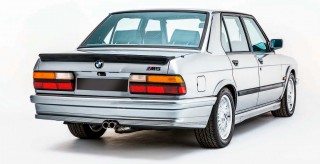
As you’d expect for a machine that’s been with us for 30 years, their numbers are dwindling but their prices have yet to go through the roof… yes, they’re on the up but it’s still possible to secure one before they enter the realm of unobtanium. It’ll be better than money in the bank as far as an investment’s concerned and will be a lot more fun to own, too.
The E28 M5 arrived at the Amsterdam Motor Show in 1985 and while there had been fast saloons before the M5 arrived, there had never been a four-door quite as rapid and rounded as the M5. BMW had already demonstrated its intent to produce some indecently rapid saloons and the E12 M535i showed how effective this sort of confection could be and with the arrival of the E28 Five in 1981 it was inevitable that BMW would build on the success of the E12 with another fast Five. True, the E12 hadn’t been a huge sales success – just 1400 were made – but it certainly reflected glory on the rest of the range. Thus in 1984 an M535i version of the E28 was shown at the Paris Motor Show and BMW could certainly have left things like that had it wished – the M535i was plenty fast enough and with its M-tuned underpinnings it handled, too.
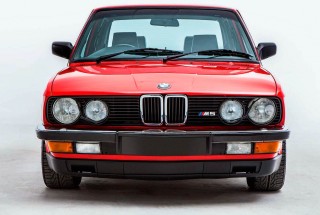
But some people always want more and it seems that there were influential BMW Motorsport customers who had enough clout to persuade BMW that it needed to go further. Indeed, when the E28 M5 made its world debut at the Amsterdam show M had, it seems, already delivered quite a few M-powered 5 Series saloons to its special customers.
The M5 received an enthusiastic reception from the world’s press, and when you have a look at what’s beneath the skin it was obvious how serious BMW’s intent was. Under the bonnet lay the same 24-valve M88 straight-six that made the E24 M635CSi such a ‘bahnstormer and this melodic engine was itself derived from the M1 mid-engined supercar. For the M5 and M635CSi its power was upped from 277hp to 286hp thanks to larger valves, a pair of 264-degree camshafts, unique con rods and pistons, and the adoption of Bosch ML-Jetronic fuel injection system over the M1’s rather troublesome Kugelfischer mechanical setup. While the engine was pretty cutting-edge for its day, M’s engineers obviously still had their eye on the Deutschmarks as items like the crankshaft were carried over unchanged from the M30 big-six that was used in the 535i and 635CSi.
BMW could also have left the M5’s underpinnings more or less unchanged from the M535i but that would have been selling the car short and to cope with the 30 per cent power increase there were a number of revisions under the skin. While the car retained its MacPherson strut/semi-trailing arm configuration, there were unique Bilstein front dampers and a larger front anti-roll bar although initially the setup at the rear retained standard E28 components. Throughout its production life the M5 gained Boge front and rear dampers and different springs at the rear plus a larger still front anti-roll bar and a thicker one at the rear, too.
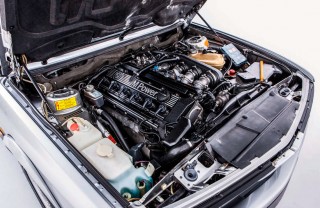
Stopping power was taken care of by 300mm vented front discs clamped by four-piston callipers, while at the back there were solid 284mm discs (as fitted to the M535i) and ABS was a standard fitment. The M5’s gearbox, the Getrag 280/5, was unique too and unlike the M535i there was no auto option. Power was transmitted to the road with the aid of a 25 percent locking limited-slip differential.
While there were a plethora of changes under the skin, the M5’s ‘plain Jane’ looks did very little to distinguish this Super Saloon from a cooking 518i. There were a couple of very discreet M5 badges – one on the front grille and one on the bootlid – and the M5 had a slightly lower front valance, but other than that it you could very easily have walked past it in a car park without giving it a second look. Early European versions were shod with metric rims and TRX tyres but as these looked no different to optional rims on other E28s they weren’t exactly a giveaway either. Later in its life the E28 M5 sported 7.5×16-inch cross-spoke alloys with 225/50VR16 rubber and the vast majority of the 187 right-hand drive cars came equipped with these.
In this pure form, the E28 M5 was one of the ultimate Q cars, an entirely anonymous-looking sober-suited four-door that was capable of embarrassing much more exotic machinery. Its plain looks must have been one of the main attractions for many owners, but they would have needed to be well-heeled, as back in 1986 when it went on sale in the UK, the M5 was an eye-watering £31,295 – a staggering £11k more expensive than the M535i, but interestingly a significant £6k less than you would have needed to slip behind the steering wheel of the similarly-powered M635CSi.
However, there were a significant number of owners who wanted their über-saloon to stand out from the crowd. As a result the M5 could be spec’d with the E28 M535i’s M Tech aerodynamic kit and in the UK around 30 percent of owners went down this route.
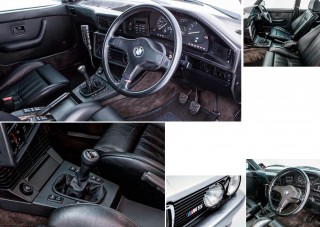
As you’d expect, UK cars tended to be quite well spec’d, but as we’re talking about a machine from 30 years ago the list of standard kit might seem a little lacklustre if you’re used to new cars today. Inside there was a leather-rimmed 380mm M-Tech steering wheel and the gear knob, gear lever gaiter and handbrake handle were all similarly clad in leather with the gear knob bearing the M tricolour stripes on its top. The vast majority of UK cars also had electric seats – they were standard for the 1986 model year – but leather was always an option in the UK.
Naturally enough you could have the standard BMW leather as an option and some cars were equipped with extended leather which included the centre console and dash too. UK models came almost exclusively with air conditioning and sunroofs too and items such as the on-board computer were also standard fitments.
As well as the European versions of the M5 (588 LHD, 187 RHD) BMW also developed a model for the US market and 1340 of these machines were manufactured. Virtually all of these US cars were black with a tan interior, with a few Canadian-spec cars and a few of the last US market machines being optioned with black extended leather. As the M5 was effectively hand-built BMW North America more or less fixed the spec of the car in order to give the guys in Munich a fighting chance of assembling enough cars to satiate demand. There were also 30 Japanese market cars, built to a very similar spec as the US machines and a further 96 machines assembled from CKD kits in South Africa. The last European machines were produced at the tail end of 1987 and the E28 was eventually replaced by the all-new E34 M5 in late 1988.
Buying one
Given the limited production numbers it shouldn’t come as too much of a surprise that you’re not going to find the classifieds full to the gunwales with E28 M5s. For this reason it doesn’t pay to be too choosy when searching for one, especially if you have a particular colour in mind.

Most popular for UK models was Lachs silver (34), followed by Diamond black (31), Dolphin grey (22) and Zinnobar red (21). Other moderately popular hues were Alpine white and Cirrus blue, but no other colours made it into double figures. Thus, if you’re searching for a Malachite green example you might have a very long wait as only two were made in that colour.
Many of these cars will be sold by word of mouth so it’s worth joining a club and getting active in the M Power section. It will also be worth letting the specialists know that you’re actively looking to buy as pretty often by the time the cars reach their websites they’re already sold!
Prices start at around £20,000 for a usable machine that’s either done high miles or is a bit rough around the edges. From there, you should be looking at a very nice example by the time you reach £40k. Above that you’ll be looking at the very best cars with low miles and low owners and signs of recent expenditure and restoration.
Engine
The BMW M88 24-valve engine is a tough old unit but unless it’s a low miler or has had a rebuild, be careful. They have proven more robust in old age than the E34 M5 units but they’re still old and won’t really appreciate being bounced off the rev limiter too often. The big thing on these is the timing chain. These are single row (simplex) and whilst perceived wisdom says they last about 100,000 miles, it’s not that simple. Whilst the twin-row duplex chain on the E30 M3 and later catalysed M88 units almost never breaks, the single row chain certainly can. What made BMW revert from the duplex chain of the original M1 engine to a simplex chain is unclear but like a reformed serial killer, the simplex chain can’t be trusted unless you have cast-iron proof that it’s been replaced. Sure, some cars have done 150,000 on one chain, others less than 100k, and it depends on how this 25-30-year-old car has been driven and maintained.
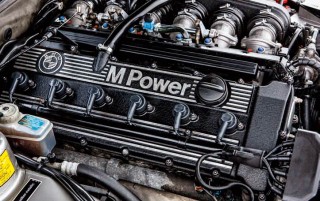
Replacing an M5 chain is an expensive job – the chain itself isn’t costly but the tensioner blades are pretty expensive and you are looking at around £800 for all the parts needed and about ten hours of labour – the sump and front timing casing come off but the head can stay on. Convert to a duplex chain? Forget it, it’s too much aggro as so many parts have to be changed and a new simplex setup is good for another 100k or the first engine rebuild. The other thing about the M88 is that everything is different to the M30 535i engine – the water pump for example is BMW only and £215.
Apart from that the M88 is a great engine. Regular oil changes, setting the valve clearances and throttles as well as warming it up carefully from cold means the M88 will do 200,000 miles, often more. If you are decent at DIY and can rebuild a Ford Pinto engine, the M88 is actually a pretty easy engine to remove and rebuild – there’s no Vanos or trickery and the top end is often easier to rebuild than an M30 for instance. The M88 is a simple but high quality unit that will repay a painstaking rebuild but be aware that a professional rebuild will be close to five figures and that good used units are very rare – some cars now have 3.6 E34 engines fitted as a result.
Exhausts are still available from BMW and aren’t overly expensive either – the rear box is £400 and the front section is about the same – so at £800 for the pair it’s not worth going the stainless steel route because it’s unlikely to fit or sound as nice. Should you need a new radiator, they are £421 from BMW with almost no aftermarket alternatives.
| ENGINE: In-line six-cylinder, DOHC, 24-valve M88 | |
|
CAPACITY: 3453cc COMPRESSION RATIO: 10.5:1 MAX POWER: 286hp @ 6500rpm |
|
|
MAX TORQUE: 251lb ft @ 4500rpm TRANSMISSION:Getrag 280 five-speed manual, LSD |
|
| SUSPENSION FRONT: MacPherson struts, coil springs, Bilstein/Boge shock absorbers, anti-roll bar | |
| SUSPENSION REAR:Semi-trailing arms with auxiliary pivot link,Bilstein/Boge shock absorbers, anti-roll barBRAKES | |
| FRONT: 300mm ventilated discs, four-piston callipers | |
| REAR: 284mm solid discs, single-piston callipers | |
| STEERING: Recirculating ball, PAS | |
| WHEELS AND TYRES: 7.5×16-inch alloys, 225/50 VR16 | |
| TOP SPEED: 152mph | |
| 0-62MPH: 6.5 seconds | |
| STANDING KM: 26.8 seconds | |
|
ECONOMY: 17.1mpg (urban), 36.2mpg (56mph) DIMENSIONS (L/W/H): 4620/1700/1400mm TRACK (F/R): 1430/1465mm |
|
|
WHEELBASE: 2625mm WEIGHT: 1470kg PRICE: £31,295 (1986) |
|
| NUMBER MADE: 187 (RHD) |
Body
Rust has no respect for the M badge and despite being hand-built, the bodyshells still came from the same Dingolfing factory as every other E28. While the E28 was superbly built and lasted well, the last one is knocking on the door of three decades old and 20-30 British winters will result in rust. Starting at the front, the edge of the bonnet can rust where the skin folds over, and the air intake scoops are also susceptible.
Good used bonnets are thinning out now – reckon on £100 minimum for a really good one while a new one from BMW is a not unreasonable £382 all-in. The front panel is standard post-’1985 but with an extra plastic front spoiler – the towing eye covers are near enough unobtainable at present.
Bolt-on front wings are a common casualty as well although they are available new from BMW at under £150 each. Like the M535i, the M5 wings have plastic arch spats that are bolted on and there are shallow depressions where the studs pass through. Doors rust mainly at the front edge as well as around where the rubber seal fits on – again, new ones are available at a price (£514) and a good used one over £100 if you can find one. Sunroof panels can rust through although good used panels are fairly plentiful. Bootlids almost never rust and rear doors seem good too. Rear arches have the plastic spats as well but look for iffy repairs underneath.
The biggest issue is probably the rear sill area. The sills can rot around all four jacking points but it’s the rear of the sill adjacent to the rear axle beam that can be rusty and expensive to fix – sorting this out involves dropping the rear axle out and some pretty involved welding work – the actual axle beam mounting points can be rotten as well and it’s a complex double-skinned area. The rear panel rusts in the corners where it meets the rear wings, whilst the fuel tanks rust around the seams and where the filler neck meets the main tank. Fuel and brake pipes are notorious for rust, especially where they snake over the rear axle beam. Other structural rust can include the inner front wings such as around the strut tops but that’s not very common.
There are three types of bumpers – standard chrome, dechromed and body colour. There’s also the M535i type plastic body kit. The latter doesn’t rust of course but does polarise opinion on its aesthetic qualities. However, steel bumpers can. New sections are available new at a high cost (£600 for the three sections of front bumper) and dechromed bumpers come in primer. An option for rusty dechromed bumpers is to find straight chrome bumpers with bad chrome and have them painted. Headlights and taillights are plentiful in decent used condition.
The E28 M5 was an anonymous-looking sober-suited four-door that was capable of embarrassing much more exotic machinery.
Transmission and drivetrain
The M5 has a bigger clutch than a standard 535i, and from BMW it will set you back a whopping £750 – companies such as C3BMW will sell the same Sachs clutch kit for a more sensible £250. The M5 gearbox is the Getrag 280 five-speed that is basically a beefier version of the 535i Getrag 260. This unit was also used in the M635CSi as well as the E34 M5 and whilst it’s strong, many have a rattly layshaft and will need a rebuild – good used units are about £1000 and you can bet many impecunious owners slotted an almost identical-looking 535i gearbox in there…
The gear change is often sloppy due to a worn out gear change knuckle. The part itself is about £35 but fitting it requires the use of a ramp and whilst you’re doing it, you might also consider fitting a Z3 shortshift gear lever as well. Be aware that the M5 gearbox is a H pattern overdrive unit – the M5 never, ever had a ‘dogleg’ gearbox – these were fitted to certain 535i and M535i cars only Propshafts don’t cause any problems other than a worn out centre bearing or doughnut. The diff is the massive Type 210 limited-slip unit and they very rarely give any grief other than a leaky seal.
Interior
As it was sold in the UK, the M5 was a very wellequipped car. They nearly all came with electric front seats, air conditioning, electric windows all-round and an on board computer. The chances of the last two working on cheaper examples are fairly remote – the OBC may well just require a back lighting bulb but good used parts to fix it aren’t too obscene. The air-con though is an old R12-based system and will most likely need an overhaul with new seals, a new condenser and a rebuilt compressor, all modified to take the later R134A gas. The E28 air-con isn’t a bad system but it’s not brilliant compared to modern cars. Many cars had leather (it’s rare to find one with the standard ‘houndstooth’ Highland cloth) but that makes it easier and cheaper to have a worn side bolster replaced – less than £100.
Electric window motors and regulators are all reliable as is the electric sunroof that still needs periodic oiling. Of more concern is the instrument cluster as this uses the SI board (a circuit board) to control the instruments and the service interval light system. This needs to work as it’s very expensive to fix – the backing plate with the circuit board is over £1000 with VAT but at least it’s the same as the regular 1986 onwards E28 and thus can be found in a good working condition for less – pay about £100 for a 1986 onwards cluster that works (four- or sixcylinder will do) and swap the board over. Many later cars also had extensive leather trimming – doorcards, dashboards as well as the centre console. A well-looked after full leather interior is a sight to behold and smells like a good shoe shop.
Wheels, tyres and brakes
Unlike early LHD cars and the first couple of UK press demo cars, the RHD E28 M5 doesn’t have the metric wheels and tyres. Instead, the car has BBS 16-inch cross-spoke alloys similar to (but not the same as) the E30 M3 rims. These were unique to the M5 and with so few being sold in the UK, the chances of finding a good used set are slim. They are still available new from BMW at a whopping £383 each and a set of decent tyres (225/50 VR16), such as a Continental Premium Contact 2 or a Michelin Primacy 3, will be just under £400 fitted. Some cars may have been fitted with different wheels – Alpina or BBS split-rims for example whilst the 16-inch E39 BBS Fundo cross-spoke looks similar – but the correct wheels need to be present if paying top dollar for a car.
The brakes are based on the 535i with the hydraulic servo, but the single-piston sliding front callipers are replaced by proper ATE four-piston iron callipers. These were fitted only to the M5 and M635CSi and were not used on anything else – older E23 and E24 callipers look similar but are not suitable. From BMW they are available at a frightening £600 each but the sensible approach would be to get them rebuilt with new seals and stainless pistons. The same problems with the hydraulic servo system applies – seizing pedal to master cylinder cross linkage pivots, a failed pressure storage sphere leading to a very hard pedal or one that sinks under load, and a knackered booster ram. None of it is particularly cheap to fix but as it’s all made by ATE, buying from ATE via a factors or companies such as C3BMW will slash costs hugely. From BMW, a pair of new discs is £323 so not too bad if you say it quickly! The rear brakes are the same as fitted to E28 M535is and many other E28s and E24s so shouldn’t break the bank to replace. The brake master cylinder, ABS block and ABS ECU are all the same as the other E28s with discs all-round.
Steering and suspension
Unlike the 535i, most UK versions of the E28 M5 used Boge dampers rather than Bilsteins along with much fatter front and rear anti-roll bars. The usual E28 issues apply here – worn out rear beam bushes, rusty front strut spring cups and so on. Luckily the big bits are the same as the 535i but the M5-specific Boge dampers are very scarce – instead, a Bilstein B6 or B8 kit is the way forward.
The infamous 55mph steering shimmy still happens and this is generally due to tired upper control arm inner bushes. You can solve this by fitting a polybush kit to the existing arms or by simply replacing the complete arms with those from BMW, Febi or Lemforder.
The steering is much the same as any other E28 complete with a steering box and drag links. The steering box itself is similar to the 535i but with a slightly quicker ratio – these are NLA, so if they’re worn out you’re need to get either a good used one or a 535i steering box as no parts are available for a rebuild. Slightly worn boxes can have the play taken out with careful adjustment and many ‘worn out’ steering boxes on these ‘80s BMWs are in fact play in the steering column splines and tightening the 32mm adjuster nut inside the car sorts it out. Moving to the rear axle again a weird wandering feel can in fact be worn out ‘dog bones’. The twin-bolt Pitman arms that link the outer part of the trailing arm to the axle beam but these are easily and cheaply replaced. Watch out as well for rotten rear spring cups – cars with the yellow Bilstein rear dampers have removable spring cups but getting new ones can be a nightmare.
Electronics
Much of this has been covered already but there are a few other bits to consider. Central locking is standard and you may find some cars also have the extra security lock underneath the main door lock. This was a factory or dealer fit option and it’s unlikely to work now. Engine ECUs are like gold dust and a faulty one is best repaired – a new one is over £2000. The M5 used the original style of Motronic with the twin-flywheel sensors that picked up a pin on the flywheel, and both these and the fuel pump/DME relays should be replaced now as a matter of course. We mentioned the instrument cluster earlier – the signs of the SI board failing are the rev counter and temperature gauge flickering but should the speedo fail, it could be a faulty plug-on diff speed sensor or even a fuse.
Servicing costs
The E28 M5 needs diligent servicing – not just changing bits but looking out for potential issues such as rusty brake pipes. Barney at Classic Heroes says that rust is the big problem with these now and as with anything this age, you need to start actively looking for corrosion and dealing with what’s there before it spreads and causes more damage. At this age it’s worth also replacing brake hoses and coolant hoses as well. The service prices on the right are from Munich Legends, but they are of course only an estimate – you’re not dealing with a ‘59-plate 320d but a 30-year-old car and things are never black and white!
| Oil service | £159 |
| Inspection I | £499 |
| Inspection II | £649 |
| Valve clearances | £239 |
| Timing chain replacement | £3360 |
Verdict
The E28 M5 is a cracking car and one that deserves its classic status and price tag. When an E Type costs over £100,000 and a really good RS2000 is over £30k, £30k or £40k for a nice E28 M5 doesn’t seem too ridiculous. Be aware though that there were quite a few rough ones about not long ago so you don’t want to buy one of those that’s been cosmetically tarted up. Mileage isn’t a huge issue although for investment purposes, one with much more than 100k will of course lag behind the low-mile unrestored mint examples.
Thanks to: Munich Legends / Tel: 01825 740456 / Web: www.munichlegends.co.uk
Classic Heroes Tel: 01825 732817 / Web: www.classicheroes.co.uk





